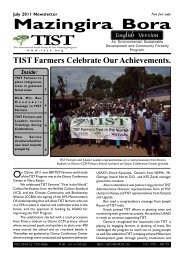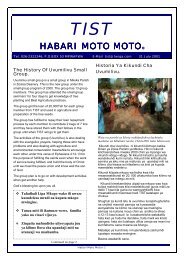Mazingira Bora - TIST
Mazingira Bora - TIST
Mazingira Bora - TIST
- No tags were found...
Create successful ePaper yourself
Turn your PDF publications into a flip-book with our unique Google optimized e-Paper software.
Most <strong>TIST</strong> Small Groups appreciate andpractice <strong>TIST</strong> Values. The success of <strong>TIST</strong>is based on the integrity and effort ofENGLISH VERSION<strong>TIST</strong> VALUES: The Foundation andStrength of <strong>TIST</strong>.individual members. Our achievements are largelyguided by each one of us keenly abiding by theseValues.In many of our activities, from tree planting,practicing Conservation Farming, improvingbiodiversity, Building or buying improved stoves,What is an indigenous tree?An indigenous, or native tree is one that is welladapted to an area because it has grown and reproducednaturally there over a long period of time.Not all species that are familiar to us are indigenous.Many have been introduced by people inareas far away. There are over 800 species of treesthat are indigenous in Kenya.Why are indigenous trees important?Because indigenous trees have evolved with thelocal environment, animals, plants, and other organismsaround them they are well suited to the area.They often require less maintenance than exotic,introduced species. They diversify our farms, so thatrisks of pest outbreaks can be lower. They providebiodiversity benefits such as habitat for wildlife anddiverse benefits for us from their fruits, timberleaves, and traditional medicine. Introduced, or exoticspecies, can provide many benefits, but somecan become weedy and crowd out other trees orcrops.When we plant indigenous trees on our farms,we are helping preserve species that have beenuseful to our mothers and fathers, to our grandparents,and to the people and wildlife of Kenya forgenerations. We are still learning about benefit ofthe many species around us. We have discoveredthat some are as fast growing as the exotic species.By Joseph Gitumateaching and practicing important health issues,protecting our lands against soil erosion and otherdegradation causes, fighting climate changes anddeforestation, protection our rivers for clean andadequate water and many others activities includingincome generating, <strong>TIST</strong> Values play a central role.In <strong>TIST</strong>, We Are. We are Honest; We areAccurate; We are Transparent; We are Servant toeach other; We are Mutually Accountable; We areRole Models; We are Volunteers.Indigenous Tree Species Have Multiple Benefits.When we plant indigenous species, we can helpensure that the trees and their benefits are therefor our children.In <strong>TIST</strong>, we have some additional biodiversityincentives for planting indigenous tree species.Groups near rivers, who follow <strong>TIST</strong>’s Best Practicefor Riparian areas and plant indigenous trees,may qualify to receive an additional incentivethrough the <strong>TIST</strong> Riparian Corridor initiative. Byhaving diverse indigenous species along the streamsand rivers, other insects, birds and animals will havethe ability to move and flourish.<strong>TIST</strong> Small Groups near protected forests, whoplant indigenous trees, may be eligible to join CFAgroups near them, to plant indigenous species andearn carbon income in these forests.Here are some of indigenous trees for Kenya;1. Muringa (Cordia Africana)2. Meru oak-muhuru (vitex keniensis)3. Mugumo, murumba (ficus thonningii)4. Podo, muthengera (podocarpus falcatus)5. Mwiria (prunus africana)6. Mutoo, Mukeu,(Dombeya rotundifolia).7. Muuti (erythrina abyssinica)8. Muuuku, (terminalia brownii)Try planting some indigenous tree in yourshamba this rainy season!3
















